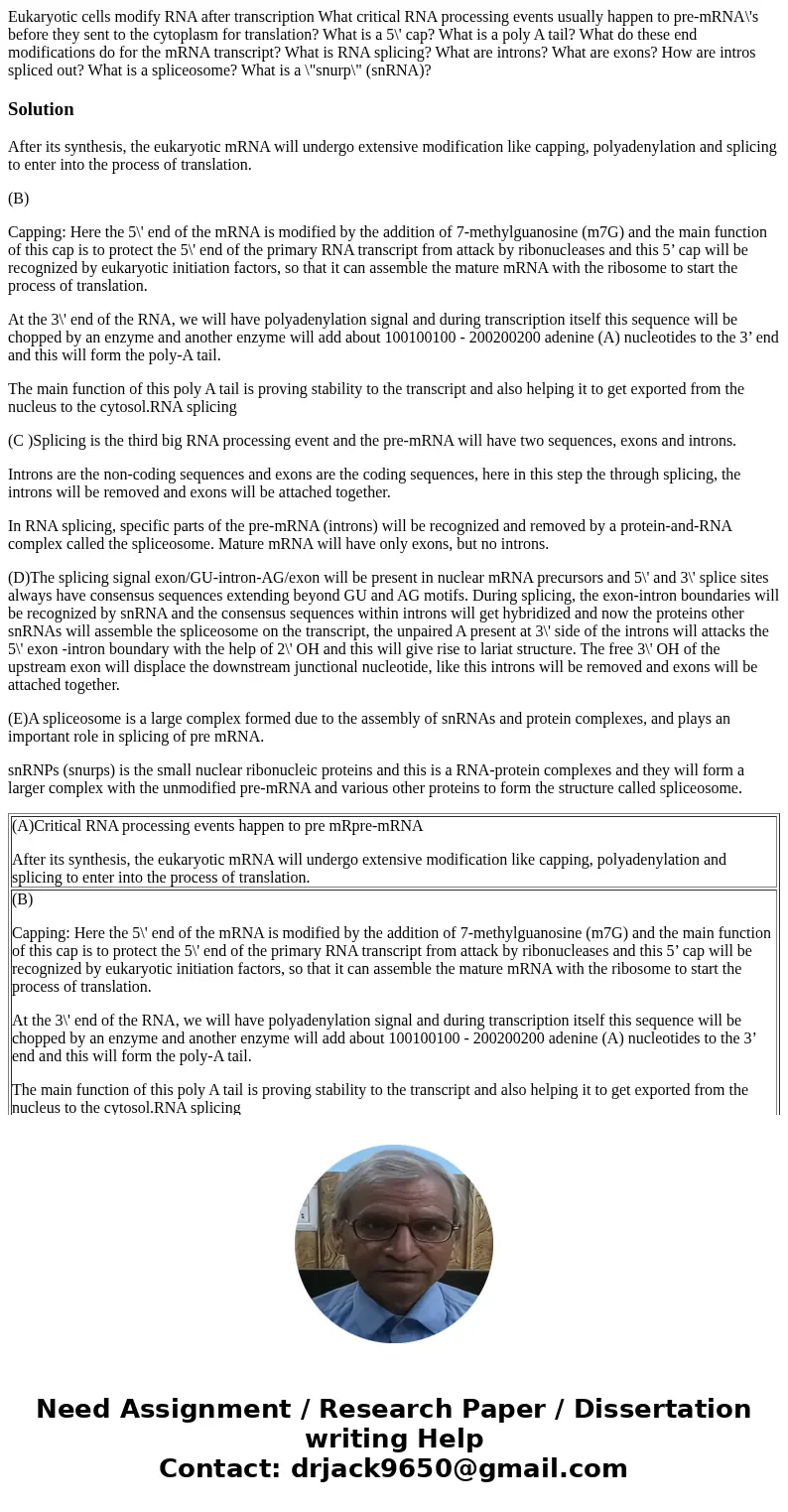Eukaryotic cells modify RNA after transcription What critica
Solution
After its synthesis, the eukaryotic mRNA will undergo extensive modification like capping, polyadenylation and splicing to enter into the process of translation.
(B)
Capping: Here the 5\' end of the mRNA is modified by the addition of 7-methylguanosine (m7G) and the main function of this cap is to protect the 5\' end of the primary RNA transcript from attack by ribonucleases and this 5’ cap will be recognized by eukaryotic initiation factors, so that it can assemble the mature mRNA with the ribosome to start the process of translation.
At the 3\' end of the RNA, we will have polyadenylation signal and during transcription itself this sequence will be chopped by an enzyme and another enzyme will add about 100100100 - 200200200 adenine (A) nucleotides to the 3’ end and this will form the poly-A tail.
The main function of this poly A tail is proving stability to the transcript and also helping it to get exported from the nucleus to the cytosol.RNA splicing
(C )Splicing is the third big RNA processing event and the pre-mRNA will have two sequences, exons and introns.
Introns are the non-coding sequences and exons are the coding sequences, here in this step the through splicing, the introns will be removed and exons will be attached together.
In RNA splicing, specific parts of the pre-mRNA (introns) will be recognized and removed by a protein-and-RNA complex called the spliceosome. Mature mRNA will have only exons, but no introns.
(D)The splicing signal exon/GU-intron-AG/exon will be present in nuclear mRNA precursors and 5\' and 3\' splice sites always have consensus sequences extending beyond GU and AG motifs. During splicing, the exon-intron boundaries will be recognized by snRNA and the consensus sequences within introns will get hybridized and now the proteins other snRNAs will assemble the spliceosome on the transcript, the unpaired A present at 3\' side of the introns will attacks the 5\' exon -intron boundary with the help of 2\' OH and this will give rise to lariat structure. The free 3\' OH of the upstream exon will displace the downstream junctional nucleotide, like this introns will be removed and exons will be attached together.
(E)A spliceosome is a large complex formed due to the assembly of snRNAs and protein complexes, and plays an important role in splicing of pre mRNA.
snRNPs (snurps) is the small nuclear ribonucleic proteins and this is a RNA-protein complexes and they will form a larger complex with the unmodified pre-mRNA and various other proteins to form the structure called spliceosome.
| (A)Critical RNA processing events happen to pre mRpre-mRNA After its synthesis, the eukaryotic mRNA will undergo extensive modification like capping, polyadenylation and splicing to enter into the process of translation. |
| (B) Capping: Here the 5\' end of the mRNA is modified by the addition of 7-methylguanosine (m7G) and the main function of this cap is to protect the 5\' end of the primary RNA transcript from attack by ribonucleases and this 5’ cap will be recognized by eukaryotic initiation factors, so that it can assemble the mature mRNA with the ribosome to start the process of translation. At the 3\' end of the RNA, we will have polyadenylation signal and during transcription itself this sequence will be chopped by an enzyme and another enzyme will add about 100100100 - 200200200 adenine (A) nucleotides to the 3’ end and this will form the poly-A tail. The main function of this poly A tail is proving stability to the transcript and also helping it to get exported from the nucleus to the cytosol.RNA splicing |
| (C )Splicing is the third big RNA processing event and the pre-mRNA will have two sequences, exons and introns. Introns are the non-coding sequences and exons are the coding sequences, here in this step the through splicing, the introns will be removed and exons will be attached together. In RNA splicing, specific parts of the pre-mRNA (introns) will be recognized and removed by a protein-and-RNA complex called the spliceosome. Mature mRNA will have only exons, but no introns. |
| (D)The splicing signal exon/GU-intron-AG/exon will be present in nuclear mRNA precursors and 5\' and 3\' splice sites always have consensus sequences extending beyond GU and AG motifs. During splicing, the exon-intron boundaries will be recognized by snRNA and the consensus sequences within introns will get hybridized and now the proteins other snRNAs will assemble the spliceosome on the transcript, the unpaired A present at 3\' side of the introns will attacks the 5\' exon -intron boundary with the help of 2\' OH and this will give rise to lariat structure. The free 3\' OH of the upstream exon will displace the downstream junctional nucleotide, like this introns will be removed and exons will be attached together. |
| (E)A spliceosome is a large complex formed due to the assembly of snRNAs and protein complexes, and plays an important role in splicing of pre mRNA. snRNPs (snurps) is the small nuclear ribonucleic proteins and this is a RNA-protein complexes and they will form a larger complex with the unmodified pre-mRNA and various other proteins to form the structure called spliceosome. |


 Homework Sourse
Homework Sourse